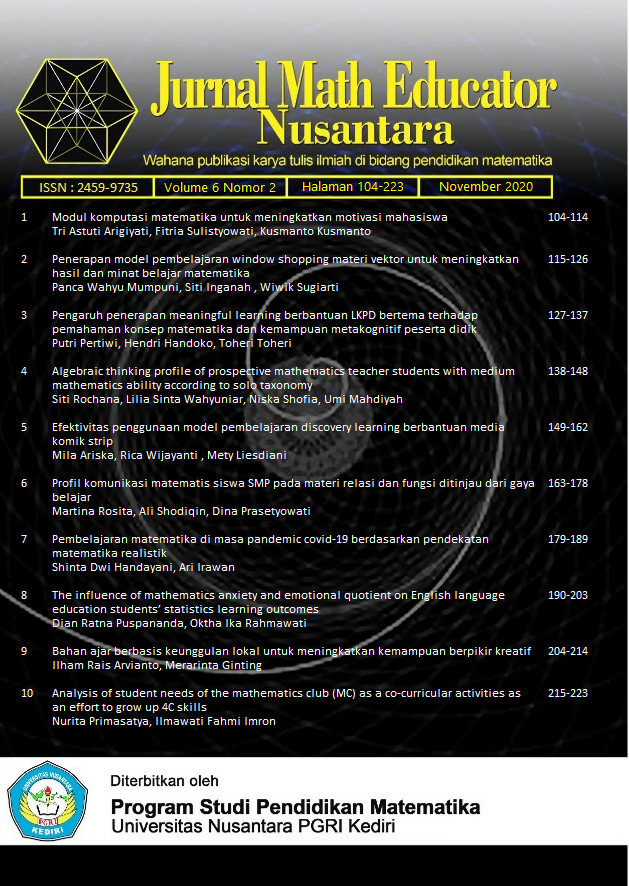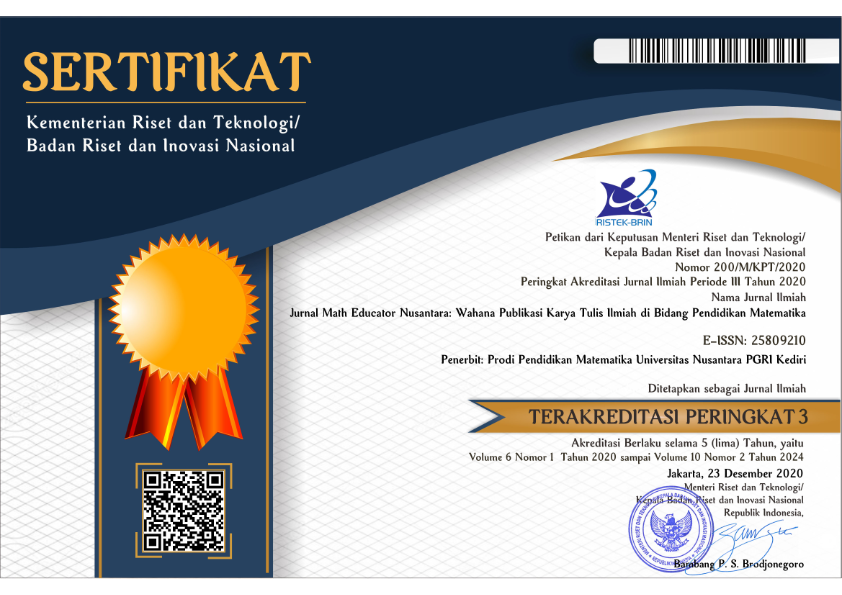Modul komputasi matematika untuk meningkatkan motivasi mahasiswa
DOI:
https://doi.org/10.29407/jmen.v6i2.14453Keywords:
module, mathematical computing, motivationAbstract
This study aims to develop a mathematics computation learning module using the Matlab program. Matlab is a computer program that is used to solve various math problems. This study uses a simplified Borg and Gall development model with the following stages: (1) product analysis; (2) initial product development; (3) Expert validation and product revision; (4) limited field trials and product revisions; (5) main field trials and final products. The first three stages have been carried out in the previous year and produced a valid Mathematical Computing module. In the limited field trial, it was found that the student response to the Mathematics Computing module was categorized as good with an average score of 3.86, while in the main trial an average score was 3.98 which was categorized good for the 6 aspects assessed. Based on these results it can be concluded that this module is suitable for use in learning mathematics computation. This module is expected to motivate students to learn Mathematical Computing so that learning objectives can be achieved.
References
Arigiyati, T.A; Kusmanto, B.; Widodo, S. A. (2018). Validasi Instrumen Modul Komputasi Matematika. Jurnal Riset Pendidikan Dan Inovasi Pembelajaran Matematika (JRPIPM), 2(1), 23-29.
Aspriyani, R. (2017). Pengaruh Motivasi Berprestasi Siswa Terhadap Kemampuan Pemecahan Masalah Matematis. JPPM (Jurnal Penelitian dan Pembelajaran Matematika), 10(1), 17-23.
Berhenke, A., Miller, A. L., Brown, E., Seifer, R., & Dickstein, S. (2011). Observed emotional and behavioral indicators of motivation predict school readlines in Head Start graduates. Early Childhood Research Quarterly, 26(4), 430-441.
Bhawayasa, I. P. (2011). Pengaruh Pembelajaran Kontekstual terhadap Hasil Belajar Fisika Peserta Didik Kelas X SMA Ditinjau dari Motivasi Berprestasi. Singaraja: Program Pasca Sarjana Universitas ...
Bungsu, T. K. (2019). Pengaruh Kemandirian BelajarTerhadap Hasil Belajar Matematika di SMKN 1 Cihampelas. Journal On Education, 1(2), 382-389.
Chandra A.P, Ibrohim, Murni S. (2016, Juni). Pengembangan Modul Pembelajaran Inkuiri Berbasis Laboratorium Virtual. Jurnal Penelitian: Teori, Penelitian, dan Pengembangan, 1(6), 1090-1097.
Frydenberg, M., & Andone, D. (2011). Learning for 21st cebtury skills. . In International Conference on Informastion Society (i-Society 2011) (hal. 314-318). IEEE.
Hamdu, G., & Agustina, L. (2011). Pengaruh Motivasi belajar siswa terhadap prestasi belajar IPA di sekolah dasar. Jurnal Penelitian Pendidikan, 12(1), 90-96.
Hendriana, H. & Soemarno, U. (2017). Penilaian Pembelajaran Matematika Edisi Revisi. Bandung: Refika Aditama.
Hendriana, H., & Soemarmo, U. (2014). Penilaian Pembelajaran Matematika. Bandung: Refika Aditama.
Innabi, H. (2003). Aspects of critical thinking in classroom instruction of secondary school mathematics teachers in Jordan. In Mathematics Education into the 21st Century Project Proceeding of the International Conference. Czech Republic.
Khan, T., Johnston, K., & Ophoff, J. (2019). The Impact of an augmented reality application on learning motivation of student. Advances in Human-Computer Interaction, 2019.
Kopacz. (2004). Color in three-dimensional design. New York: McGraw-Hill.
Law, K. M. Y., Geng, S., & Li, T. (2019). Student enrollment, motivation and learning performance in a blended learning environment: The mediating effects of social, teaching, and cognitive presence. Computer & Education, 136, 1-12.
Lestari, K. E. (2014). Implementasi Brain-Based Learning untuk meningkatkan kemampuan koneksi dan kemampuan berpikir kritis serta motivasi belajar siswa SMP. Judika (Jurnal Pendidikan Unsika), 2(1), 36-46.
Moeloek, F. A., Wirakartakusumah, M. A., Indrayanto, G., Gunawan, J., Indrajit, R. E., & Jamma, J. (2010). Paradigma Pendidikan Nasional Abad XXI. Jakarta: BNSP.
Mulyaningsih. (2014). Pengaruh interaksi sosial keluarga , motivasi, dan kemandirian belajar terhadap prestasi belajar. Jurnal Pendidikan dan kebudayaan, 20(4), 441-451.
Muslihat, I., Andriani, D., & Zanthy, L. S. (2019). Analisis kemampuan koneksi matematis dan motivasi belajar siswa SMK. Journal on Education, 1(3), 173-181.
Nuraini, N. L. S., & Laksono, W. C. (2019). Motivasi Internal dan Eksternal Siswa Sekolah Dasar pada Pembelajaran Matematika. Sekolah Dasar: Kajian Teori dan Praktik Pendidikan, 28(2), 56-64.
Rahdiyanta, D. (2016). Teknik Penyusunan Modul. Artikel.(Online) http://staff. uny. ac. id/sites/default/files/penelitian/dr-dwi-rahdiyanta-mpd/20-teknik-penyusunan-modul. pdf.
Rohendi, D., &Dulpaja, J. (2013). Connected Mathematics Project (CMP) model based on presentation media to the mathematical connected ability of junior high school student. Journal of Education and Practice, 4(4).
Sari, S. M. (2005). Peran Warna Interior terhadap Perkembangan dan Pendidikan Anak di Taman Kanak-Kanak. Dimensi Interior, 2(1), 22-36.
Siagian, R. E. (2015). Pengaruh Minat dan kebiasaan belajar siswa terhadap prestasi belajar matematika. Formatif: Jurnal Ilmiah Pendidikan MIPA, 2(2), 122-131.
Soenarto. (2015). Pengembangan Multimedia Pembelajaran Interaktif. Jurnal Inotek, 9(2), 175-185.
Sugiyono, P. D. (2010). Metode Penelitian Pendidikan. Pendekatan Kuantitatif. Bandung: Alfabeta.
Sulistyowati, F., Budiyono, & Slamet, I. (2017). The didactic situation in geometry learning based on analysis of learning obstacles and learning trajectory. In AIP Conference Proceedings, 1913.
Sulistyowati, F., Kuncoro, K. S.,Setiana, D .S.,& Purwoko ,R.,Y. (2019). Solving high order thingking problem with a different way in trigonometry. Journal of Physics: Conference Series, 1315(12001).
Sundayana, R. (2016). Kaitan antara gaya belajar, kemandirian belajar, dan kemampuan pemecahan masalah siswa SMP dalam pembelajaran matematika. Mosharafa: Jurnal Pendidikan Matematika, 5(2), 75-84.
Trilling,B.,&Fadel,C. (2009). 21st Century Skills: Learning for life in our times. San Francisco: John Wiley & Sons.
Yektyastuti, R., & Ikhsan, J. (2016). Pengembangan Media Pembelajaran Berbasis Android pada materi Kelarutan untuk meningkatkan Performa Akademik Peserta Didik SMA. Jurnal Inovasi Pendidikan IPA, 2(1), 1-9.
Downloads
Published
Issue
Section
License
Authors who publish with this journal agree to the following terms:
- Copyright on any article is retained by the author(s).
- The author grants the journal, the right of first publication with the work simultaneously licensed under a Creative Commons Attribution License that allows others to share the work with an acknowledgment of the work’s authorship and initial publication in this journal.
- Authors are able to enter into separate, additional contractual arrangements for the non-exclusive distribution of the journal’s published version of the work (e.g., post it to an institutional repository or publish it in a book), with an acknowledgment of its initial publication in this journal.
- Authors are permitted and encouraged to post their work online (e.g., in institutional repositories or on their website) prior to and during the submission process, as it can lead to productive exchanges, as well as earlier and greater citation of published work.
- The article and any associated published material is distributed under the Creative Commons Attribution-ShareAlike 4.0 International License














